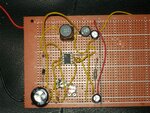boylesg
Advanced Member level 4
- Joined
- Jul 15, 2012
- Messages
- 1,023
- Helped
- 5
- Reputation
- 10
- Reaction score
- 6
- Trophy points
- 1,318
- Location
- Epping, Victoria, Australia
- Activity points
- 11,697
This online calculator is pretty straight forward, but I was going to use the formulas in the data sheet to make my own calculator in a Excel spread sheet.:
**broken link removed**
In the online calulcator the value of the inductor (Lmin) is calculated.....simple enough.
But in the datasheet the value of a inductor is also calculated (Lmin) but there is also other inductor value at the top of each column for step up (170uH), step down (220uH) and inverting (90uH) calulcations.
What are these inductor values about and how do they relate to the formulas below them?
**broken link removed**
In the online calulcator the value of the inductor (Lmin) is calculated.....simple enough.
But in the datasheet the value of a inductor is also calculated (Lmin) but there is also other inductor value at the top of each column for step up (170uH), step down (220uH) and inverting (90uH) calulcations.
What are these inductor values about and how do they relate to the formulas below them?

